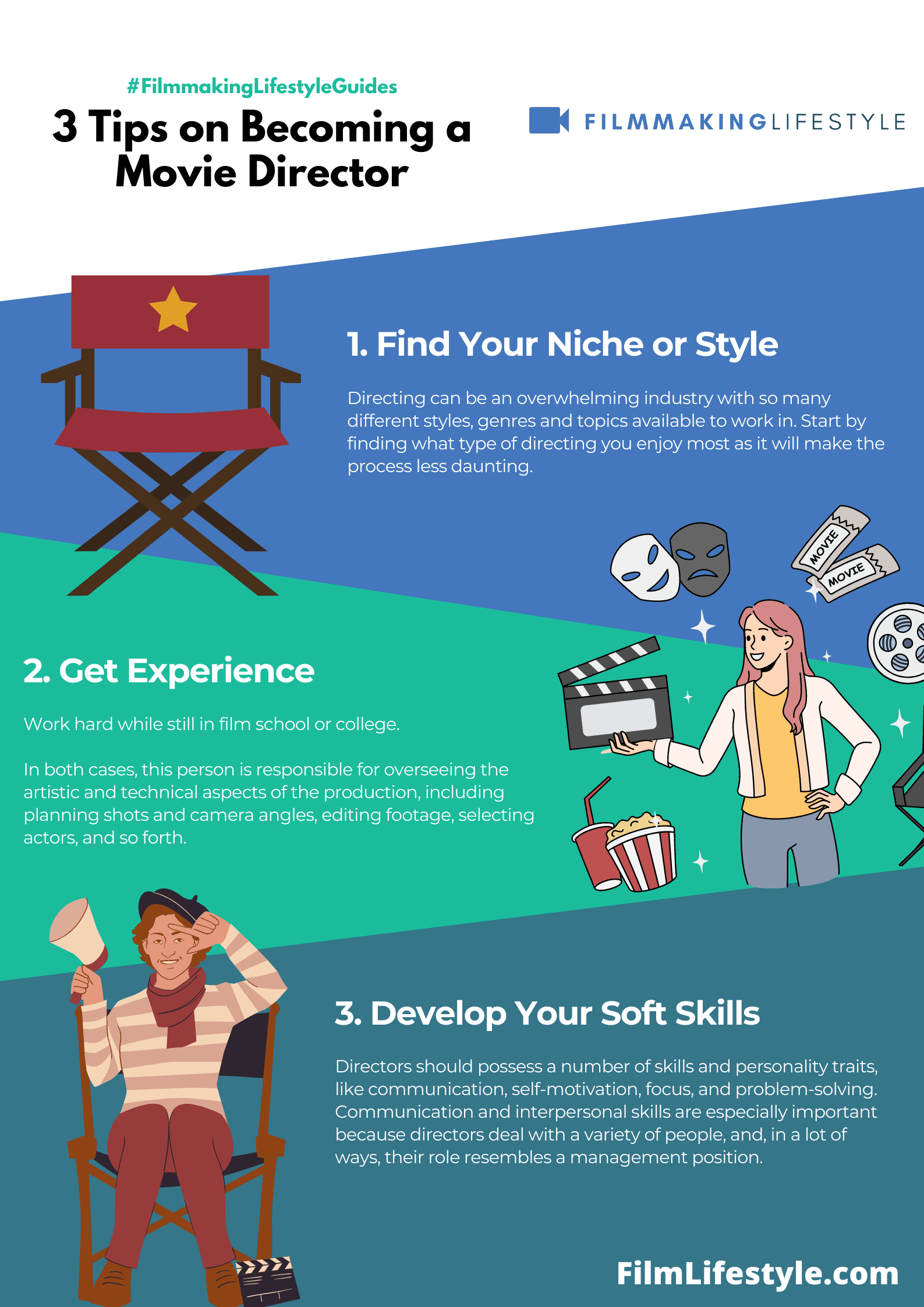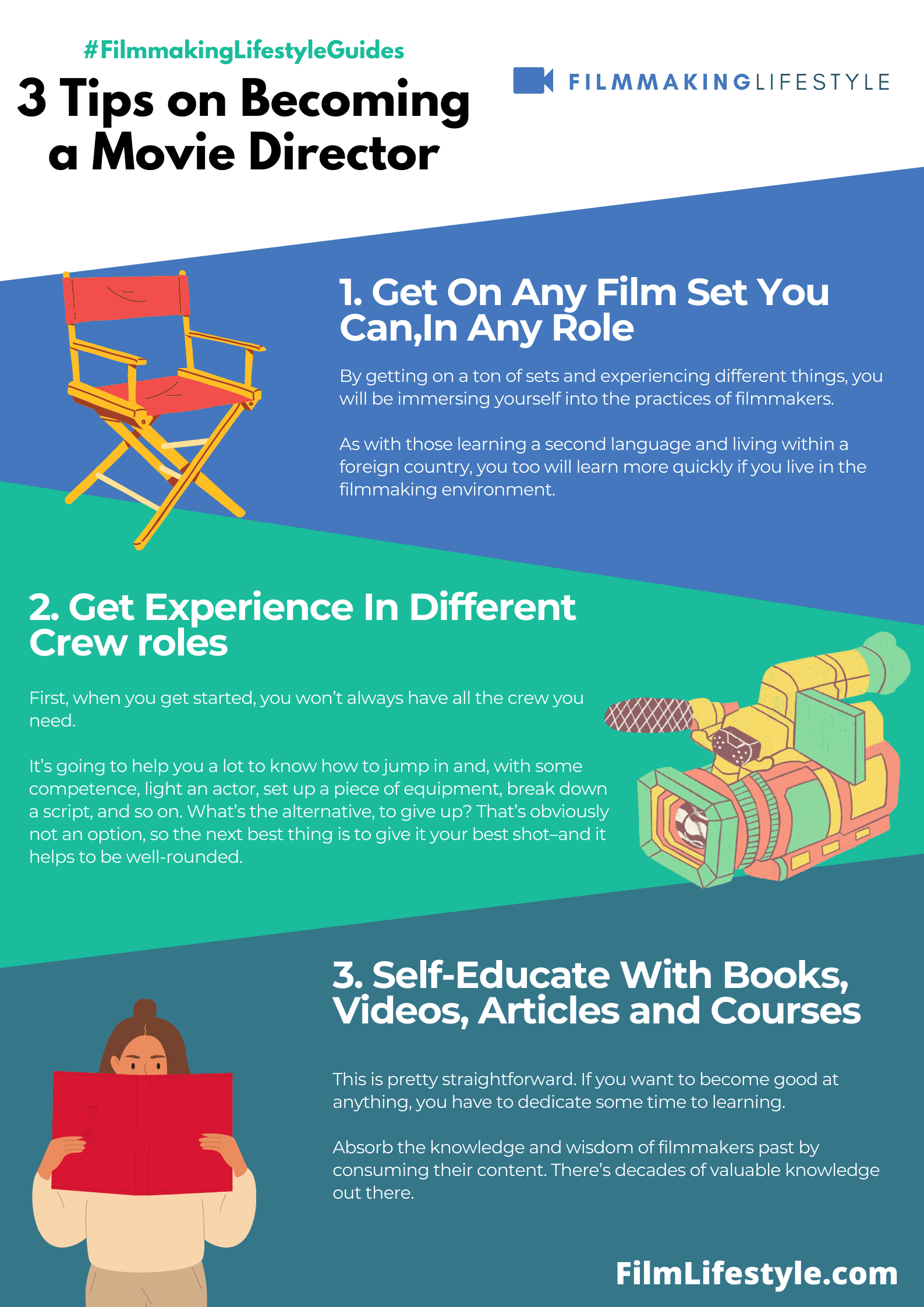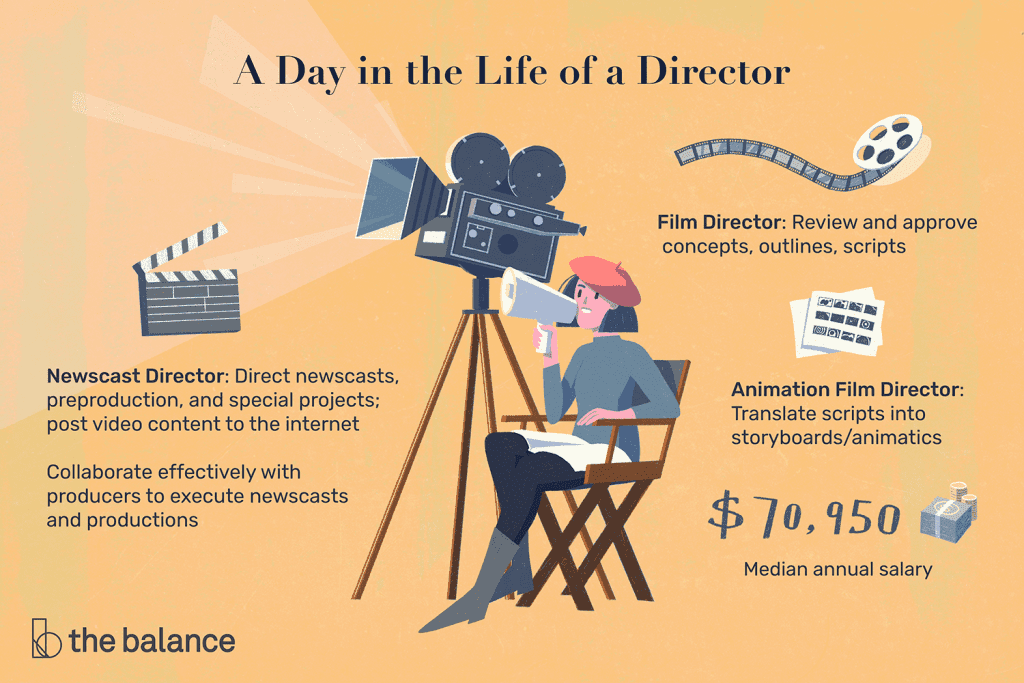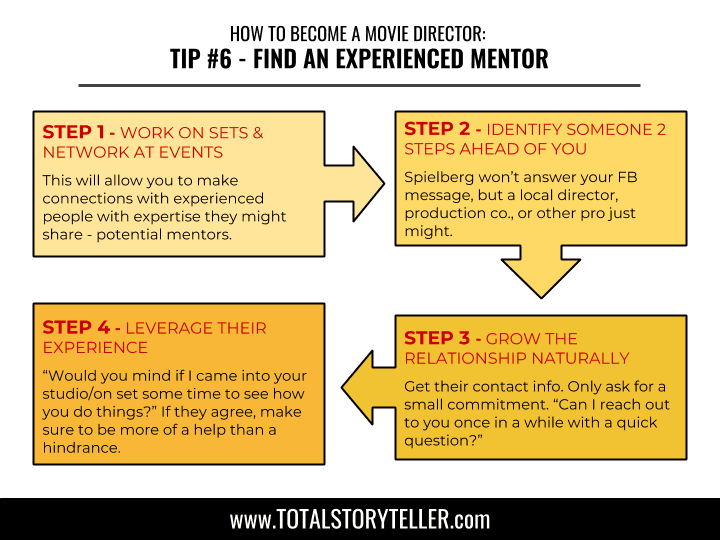A movie director is in charge of the creative and technical aspects of a film. This person directs actors, oversees the script and editing process, and manages the many departments involved with production.
A director can be responsible for one project or multiple projects at once, depending on their experience level within the industry.
A directors job description includes being able to:
1. Understand what it means to work as a team player and to collaborate with others,
2. Develop an idea from conception through completion,
3. Think strategically about how best to use limited resources while still meeting deadlines,
4. Create a vision that inspires teams to do their best work,
5. Manage relationships among all those who are working together including investors, crew members, cast, etc.
WHAT DOES A MOVIE DIRECTOR DO
What Is The Movie Director’s Role?
Many people have a misconception of what a movie director does. They think that they are in charge of everything, with the power to make decisions and change things on their own.
That may be true in some indie and small-scale productions. But in larger movie productions, directors work closely with many different people including producers, actors, editors, and cinematographers to create the final product.
A movie director is indeed the person who oversees all aspects of a film production from pre-production to post-production and is responsible as the ‘vision’ of the film. They are responsible for directing the actors and crew, as well as overseeing the editing of footage they’ve filmed.
Ever wondered who’s the maestro behind the cinematic symphonies we adore?
That’s the movie director, wielding the baton that orchestrates every frame of a film.
From the subtle nuances of an actor’s performance to the grand spectacle of an action sequence, they’re the visionaries turning scripts into the stories that captivate us.
In this article, we’ll peel back the curtain to reveal what a movie director really does.
We’ll explore their pivotal role in pre-production, the chaos they navigate on set, and how they shape a film’s final cut.
Whether you’re an aspiring filmmaker or a movie buff, get ready to gain a deeper appreciation for the director’s craft.
What Is A Movie Director?
A movie director is the creative force that drives a film from concept to completion.
They’re the orchestrators of storytelling, responsible for translating a script’s words into powerful visual narratives.
The role encompasses a wide spectrum of artistic and managerial tasks – balancing the creative with the practical.
It’s their vision that guides every department, ensuring the movie’s integrity remains intact from the storyboard to the screen.
Directors are more than just the bridge between an idea and its execution.
They serve as the project’s leader, meticulously overseeing the intricate process of filmmaking.
Cast choices, location selections, and the art direction are all within their purview.
They work closely with the cinematographer to establish the film’s look and feel, with the actors to flesh out characters, and with the editors to shape the film’s rhythm and pace.
In The Godfather, Francis Ford Coppola masterfully showcased what it means to helm a complex narrative.
While in Get Out, Jordan Peele exemplified how directors can embed social commentary within gripping storytelling.
Many directors also have a signature style – think of the visceral energy in a Quentin Tarantino movie or the whimsical charm found in Wes Anderson’s work.
Beyond the obvious artistic vision, the director must:
- Ensure coherence across all creative aspects – Maintain control during the organized chaos on set – Collaborate with producers on budget and schedule constraints – Communicate effectively with department heads and crew – Resolve issues and make quick decisions under pressure.
The director’s toolkit is extensive, with leadership qualities just as critical as creative sensibilities.
Whether it’s a blockbuster or an indie film, the director’s role is pivotal.
They are the captains steering the ship, committed to delivering stories that resonate and entertain.
The Director’s Role In Pre-production
In pre-production, the director’s vision for the film begins to take shape.
We’re involved in crafting the story, refining the script, and developing a unique style and tone.
It’s in this phase that we cast the pivotal roles.

We meticulously select actors who can bring our characters to life and complement each other’s performance.
We scout locations that perfectly embody the world of our story.
Each space must not only match our creative vision but also be logistically practical for shooting.
We work closely with the production designers to establish the film’s aesthetics.
Our input is crucial in the design of sets, costumes, and the overall visual direction.
Collaboration with the director of photography is vital.
We decide on the film’s visual language – the look, color palette, and how the camera will tell the story.
Budget constraints often require our creative ingenuity.
We find innovative ways to tell our story without compromising its integrity or visual impact.
We hold meetings with department heads to ensure everyone is on the same page.
These conversations help solidify our approach and iron out any potential issues before filming starts.
The pre-production phase is demanding.
It’s a time where we lay down the groundwork for successful principal photography and eventually, a compelling film.
Our ability to manage time and resources effectively becomes particularly important.
Every decision we make during pre-production can significantly affect the final product.
Bringing The Vision To Life On Set
Once pre-production wraps, it’s on to the bustling environment of the film set.
Here, the director’s vision must evolve from the page to the screen.
On set, directors face the task of guiding both cast and crew through the minutiae of each day’s shot list.
Timing is often tight, and it’s our job to keep everything moving briskly.
Every scene demands our meticulous attention.
We orchestrate the actors’ performances, ensuring they align with the characters’ motives and the story’s tone.
We collaborate with the Director of Photography to craft the visual style of the film.
This partnership balances the aesthetic with the logistical, producing shots that tell our story effectively.
We address challenges as they arise on set – – Unforeseen weather changes
- Equipment malfunctions,
- Time constraints.
Our decisions must be decisive and informed, adapting quickly to maintain the integrity of the shoot.
Continuity errors can derail the believability of a film, so we work closely with script supervisors.
This ensures that elements of each scene remain consistent from shot to shot.
As the glue that holds everything together, we bridge the gap between anticipation and reality.
It’s through our firm direction that iconic moments are born – think of the thrill in Jaws or the poignancy in Schindler’s List.
With every frame, directors mold raw footage into pieces of unforgettable cinema.
Directing Actors And Crew
Maintaining a harmonious set while directing actors and the crew is
We understand that the director’s ability to convey their vision clearly and motivate their team is a critical factor for success.
The director’s interaction with actors is especially crucial; it’s a nuanced process that requires a symbiotic relationship.
We build trust and rapport, enabling the actors to jump deeper into their characters and deliver compelling performances.
Engaging effectively with the crew is another indispensable aspect of the director’s role.
We are the linchpin that ensures each department functions cohesively towards a unified creative aim.
Communication Skills are at the heart of directing.
We are adept at: – Tailoring our language to suit actors’ individual styles – Keeping instructions concise and to the point – Encouraging feedback to foster a collaborative environment
Problem-Solving on set is a regular duty.
We tackle issues head-on, whether they are creative differences, logistical hurdles, or unexpected weather changes.
During production, we remain the chief decision-maker, carefully balancing the artistic with the practical.
Our directorial choices affect every aspect of the final cut – from the nuances of an actor’s performance to the lighting in a scene.
We collaborate closely with the Director of Photography to establish the film’s visual language.
This partnership defines the aesthetic tone, as seen in movies like Inception or Drive, where visual storytelling is
Our job doesn’t stop with the end of the shooting schedule; we’re also deeply involved in the post-production phase.
Watching dailies, providing feedback on edits, and ensuring the film’s message is coherent and impactful are part of our daily routine.
Every decision we make, every piece of guidance we offer, contributes to sculpting raw performances and technical work into the captivating story audiences will experience.
It’s a journey of transformation, one in which we take the lead, guiding our team toward the shared goal of creating something extraordinary.
Shaping The Final Cut
In the post-production phase, a director’s vision comes to fruition.
It’s during this time that we see the director’s true storytelling aptitude as they navigate the editing process.
A director works closely with the film’s editor.
Together, they sculpt the film’s narrative pace and tone, influencing how the story unfolds for the audience.
The raw footage undergoes a transformation here.
They determine the rhythm, selecting the shots that best convey the intended emotion and forwarding the plot.
Sound design, too, is a crucial element –
- It complements the visual component,
- It enhances the ambience,
- It can elevate the story’s impact.
Color grading plays a pivotal role in setting the film’s aesthetic.
A director’s involvement ensures that the movie retains its visual consistency throughout.
Visual effects (VFX) are a part of many modern films.
The director must have a clear vision for how VFX integrates with live-action footage to create a seamless experience.
Creating a compelling score is essential.
Directors often collaborate with composers to ensure that the music aligns perfectly with their creative vision.
The director’s involvement doesn’t wane after the film is edited.
Marketing and distribution strategies benefit from a director’s insight, shaping how the film is presented to potential viewers.
The journey from script to screen is a collaborative effort.
It’s one that demands a director’s attention at every turn, ensuring that the finished product stands as a testament to their distinctive artistic voice.
What Does A Movie Director Do – Wrap Up
We’ve seen that the role of a movie director is multifaceted and pivotal to the success of a film.
Directors are not just the visionaries but the linchpins that hold the entire production together ensuring every element aligns with the intended story.
Their unique touch can turn a script into a cinematic masterpiece that resonates with audiences and stands the test of time.
With their hands steering the project from inception to the final cut and beyond directors shape the movie-going experience in ways that are both profound and lasting.
It’s their dedication and skill that bring our favorite stories to life on the big screen.
Frequently Asked Questions
What Is The Primary Role Of A Movie Director?
A movie director is the creative leader responsible for transforming a script into a cohesive visual narrative, overseeing all aspects of the filmmaking process from cast and location selection to art direction.
How Do Directors Like Francis Ford Coppola And Jordan Peele Showcase Their Skills?
Directors such as Coppola and Peele showcase their skills through their ability to create distinctive and powerful films like “The Godfather” and “Get Out,” which are recognized for their unique storytelling and visual style.
What Are The Responsibilities Of A Director During Production?
During production, a director’s responsibilities include maintaining coherence across all creative aspects of the film, controlling the set environment, collaborating with producers, and communicating effectively with the crew and department heads.
How Involved Is A Director In The Post-production Process?
Directors are highly involved in post-production, working with the editor to shape the final cut, deciding on the narrative’s pace and tone, selecting shots, and ensuring visual consistency through sound design, color grading, and visual effects.
Do Directors Play A Role In The Marketing And Distribution Of A Film?
Yes, directors often influence marketing and distribution strategies, helping to shape how the film is presented to potential viewers and ensure that the marketing aligns with the film’s vision and message.




Matt Crawford
Related posts
10 Comments
Leave a Reply Cancel reply
This site uses Akismet to reduce spam. Learn how your comment data is processed.



I’m so excited to learn more about being a film director! This blog post is so informative.
Thanks, Mitchell.
I’m so excited to learn more about being a film director! This blog post has everything I need to know.
Great stuff, Greg.
I’m so excited to learn more about being a film director! This blog post is so informative.
Thanks, August.
This post provides an informative and comprehensive overview of the role of a movie director, including their responsibilities, challenges, and the creative process involved in bringing a film to life. It is a great resource for anyone interested in understanding more about this profession or considering it as a career path.
Thanks, Isabella.
I found this post to be incredibly informative and helpful in understanding the role of a movie director. As someone who is interested in pursuing a career in filmmaking, I appreciate the breakdown of the various responsibilities and tasks that a director must handle. The section on creative vision and collaboration was particularly enlightening, as it highlighted the importance of working closely with other members of the film crew to bring a project to life. Overall, a great read for anyone looking to learn more about the film industry and the vital role that directors play.
Thanks!